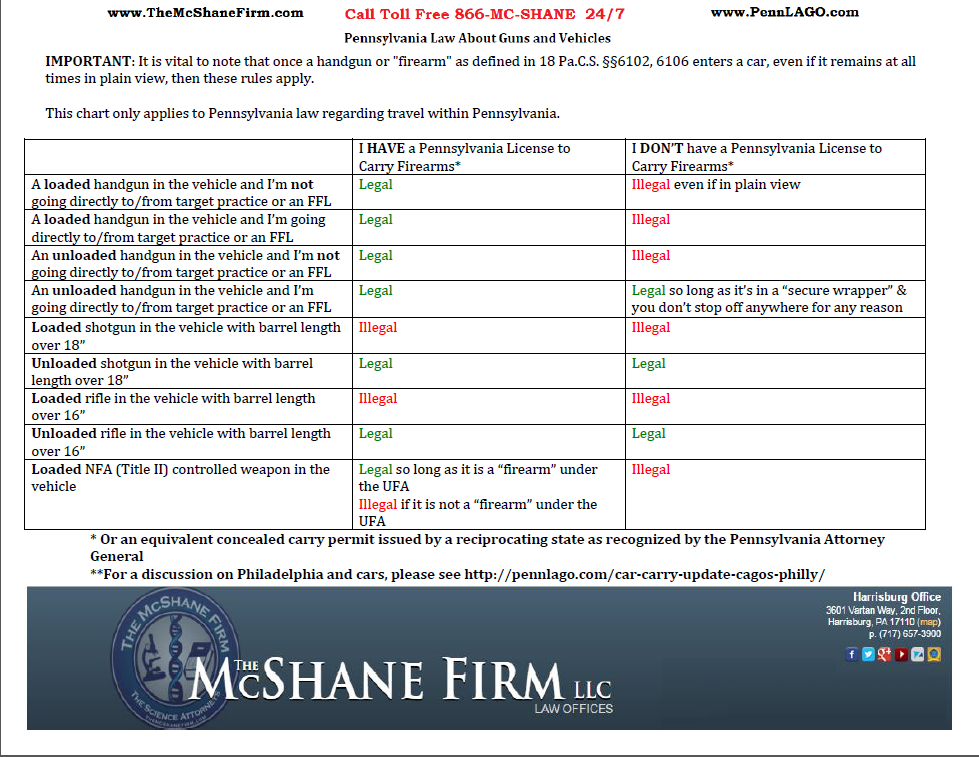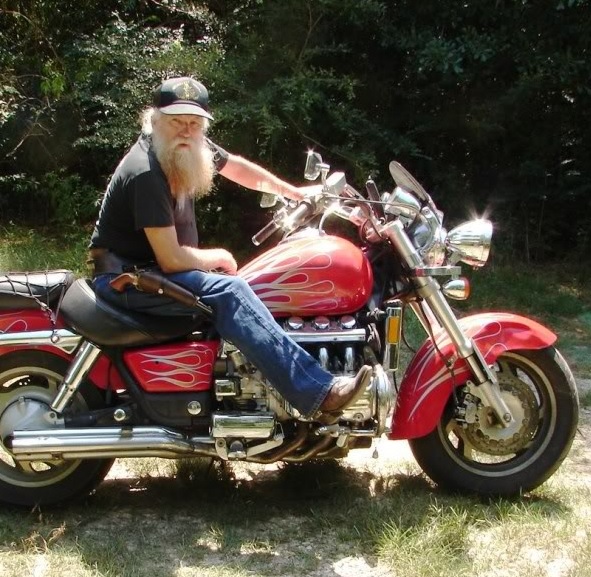Pennsylvania Law About Guns and Vehicles: Proceed with Caution
Approximately 95% of Americans own a car. It stands to reason that many Law Abiding Gun Owners (LAGOs) are also CAGOs (Car Appreciating Gun Owners). Pennsylvania has some very unique approaches when it comes to having firearms in your car, and it’s very important to take note of them. [Just so we are clear, when we write about car, we really mean all forms of vehicles… trucks, pick-up trucks, work trucks, cars, and the like.]
When we talk firearm in this blog post, we mean the Pennsylvania definition, which basically means a handgun.
Car carry in Pennsylvania is governed in part by 18 Pa.C.S.A. § 6106. In many states, it is no problem to have a firearm (meaning a handgun) in your vehicle whether you have a license to carry a firearm or not. In Pennsylvania, this is not the case. The minute you enter your vehicle with your firearm (meaning a handgun), it becomes covered under 6106.
Even if your handgun is on your hip, open and exposed, and even if it is on the dash so everyone can see it, the minute you get in the car, it might as well be in your shoulder rig under a jacket.
Under §6106, “any person who carries a firearm in any vehicle or any person who carries a firearm concealed on or about his person, except in his place of abode or fixed place of business, without a valid and lawfully issued license under this chapter commits a felony of the third degree.”
Because the section has a specific definition for the term “firearm” and the wording as a whole raises all sorts of questions, we have conveniently compiled a chart which covers the basics of car carry in Pennsylvania. Click on the chart, print it out, and use it for general reference. Please remember that laws are constantly changing. But as of today, in Pennsylvania, this is the standing law.
As you can see, unless you have a Pennsylvania License to Carry Firearms (LTCF), there are only select circumstances in which you can have a gun in your vehicle. As listed, you are not breaking the law if you have non-NFA regulated shotguns or rifles in your car, provided they are not loaded.
Again, handguns are more tricky. Absent a LTCF, you may only have a handgun in your vehicle if:
- You’re driving a car which belongs to you, your spouse, or your parent and the gun belongs to a parent or spouse who holds a valid LTCF; or
- It’s unloaded and you’re transporting it
- to or from target practice
- to or from a Federal Firearms Licensee
What does “to or from” mean? It means don’t make any stops. Don’t stop to eat lunch. Don’t stop for gas. Don’t stop at the McDonald’s drive thru for the McRib. Don’t go to the store to pick up a few things. Gas up in advance and use the restroom before you get behind the wheel with the handgun. The last thing you need as a LAGO is to explain to an officer how you’re coming straight “from the shooting range” yet you’re pulling out of the grocery store parking lot. Also, it must be completely unloaded. Be sure to remove all bullets from your chamber and magazine.
What qualifies as a vehicle? The legislature didn’t provide us with a concrete definition. Furthermore, to date, the court has not interpreted what constitutes a “vehicle” under the statute. Perhaps providing guidance (and equally as important, perhaps not) the Justification section in Title 18 defines a vehicle as “[a] conveyance of any kind, whether or not motorized, that is designed to transport people or property. ” 18 Pa.C.S. § 501. This has no direct bearing on § 6106, but it gives us insight as to what the legislature may have had in mind.
Title 75 (The Motor Vehicles Code which is different than where 6106 is which is in Title 18) additionally defines vehicle, this time as “every device in, upon or by which any person or property is or may be transported or drawn upon a highway, except devices used exclusively upon rails or tracks. The term does not include a self-propelled wheel chair or an electrical mobility device operated by and designed for the exclusive use of a person with a mobility-related disability.” 75 Pa.C.S. § 102. Again, this definition is clearly not authoritative with regards to §6101.
Because these definitions are so broad, it would be wise to apply these restrictions to all vehicles, until the courts or legislature tell us otherwise.
Does that mean motorcycles? For now, yes. It is important to note that it would appear §6106 is intent on dealing with “concealed” firearms. While carrying a firearm in saddlebags is fairly obviously a form of concealing a firearm, open carry on a motorcycle is in no way, shape or form concealed. However, the statute specifically mentions “any vehicle.” Not car, not automobile, but vehicle, which includes a motorcycle in the remainder of Pennsylvania’s statutory definitions. Accordingly, without a License to Carry Firearms, it is best to avoid traveling with a firearm on a motorcycle.
What about motor homes? This gets increasingly tricky. Again, devoid of any clarification from the legislature or interpretation from the court, it is best to err on the side of caution. Do motor homes transport people? Absolutely. Based upon the other definitions of vehicle provided, it seems like a motor home would be a dead ringer. Further, if the law is aimed at preventing concealed carry of firearms without a license, it would be more likely that a motor home would be included, as it is quite difficult to “openly” carry a firearm in a motorhome, the way you at least arguably could while riding a motorcycle.

Man Bear Pig from South Park…Half Man, Half Bear, Half Pig. Retrieved from beforeitsnews.com on December 15, 2014.
There may be one issue with the definition applying to motor homes, however. The Supreme Court has recently held that the Second Amendment guarantees the right of citizens to possess guns —at least in the home— for self-defense purposes. District of Columbia v. Heller, 554 U.S. 570. As a result, can Pennsylvania possibly prevent citizens from keeping firearms in their motor homes without a license? It may be helpful to draw distinctions. Maybe there can be no black and white rule when it comes to motor homes. Perhaps, like many other legal issues, it depends. A motor home is kind of like Man Bear Pig: half vehicle, half home, half . . . pig? If a motor home is not used as a primary residence, but is used predominantly for travel, it seems likely that it would be considered a vehicle under this section. Additionally, in such an instance, it appears less likely that the restriction would crumble under constitutional scrutiny. If the motor home is the primary residence, is planted in a lot, hooked up to utilities, has no wheels or wheels on blocks, and doesn’t move, it would appear less reasonable to consider that motor home a “vehicle” under the statute. Even if the motor home is in fact the primary residence, it is likely that any time it is in motion, it will be considered a vehicle. So while a completely stationary motor home which is a primary residence may fall outside the lines, there is a very strong basis for §6106 to apply to motor homes otherwise. Until we get some binding authority which clears this up, absent a License to Carry Firearms, it is best to keep your firearms out of your motorhome.
Because Pennsylvania takes the minority approach, some of these laws might not coincide with your intuitions. As a result, familiarize yourself with the firearms laws which deal with vehicles. Print the chart, and use it as a basic guide, but be sure to keep yourself abreast to never-ending developments in the law.


